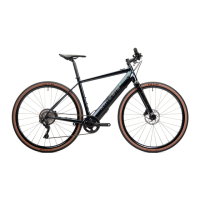are special chemical cleaners available on the market designed specically for cleaning
these surfaces. Bicycle brakes have been designed to control the speed of your bicycle
by reducing it or preventing the bicycle from moving. The maximum breaking force for
each wheel is achieved just before the moment the wheel stops rotating (“locks up”)
and starts skidding. The instant it has begun to skid, the most of your bike’s stopping
power and all directional control is lost. Therefore, it is necessary to learn how to slow
down your bike and bring it to a halt smoothly avoiding a wheel lockup.
To do so, you should learn a progressive brake modulation technique so that you could
be able to precisely and accurately control the amount of clamp force on a rotor with
a given amount of lever input. Instead of pushing the brake lever abruptly, squeeze
it slowly, and gradually increase the braking force. The instant the wheel begins to
lock up, slightly release pressure to keep it rotating. You should learn how much brake
lever pressure is needed for each wheel at dierent speeds and on dierent surfaces.
Reducing the bike speed by applying one or both brakes will transfer the weight to
the front wheel as the rider’s body continues at the speed at which it was going. Heavy
braking will result in the transfer of weight around the front wheel hub, which may send
the rider’s body ying over the handlebars. Greater brake pressure is needed for a wheel
burdened with heavier load to lock up, whereas a wheel burdened with less weight
will lock up with less brake pressure applied. Thus, when your weight is transferred
forward when the brakes are activated, you should move your body backwards in order
to transfer weight to the back, simultaneously decreasing the rear braking force and
increasing the front braking force. It is especially important when you are descending.
You should practice braking and weight transfer techniques in safe places free from
trac and distractions.
CONTROL POSITION ADJUSTMENTS
It is possible to adjust the angle and position of brakes and shift controls on the
handlebars. Ask your dealer or bike shop to make the necessary adjustments for you.
If you choose to adjust the control lever angle on your own, be sure to re-tighten
the clamp fasteners to the recommended torque (see the manufacturer’s instruction
manual).
BRAKE REACH
In many bikes brake levers can be adjusted for reach. If your hands are small or if
squeezing the brake levers is dicult for you, ask your dealer to adjust the reach or have
shorter reach brake levers tted.
WARNING: With shorter brake lever reach, correct adjustment of brakes becomes more
critical, full braking power should be applied within available brake lever travel. Brake
lever travel inadequate for full braking power application can result in loss of control,
which may cause serious injury or death.
Check the brake cables and their housing for kinks, rust, broken strands, or frayed
ends. If you notice any damage, you should ask a bicycle shop to replace the cables

